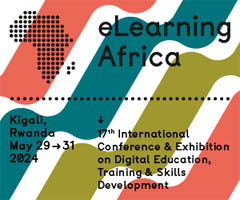One on One: The Player against the Machine
 Milano (I), November 2015 - Stefano Menon, from the Fondazione Politecnico di Milano, will present "PLAY4GUIDANCE: A New Way to Evaluation and Guidance through Business Games". The session in which Stefano will participate at OEB answers the question "Student + Gamification = Engagement?". The meeting (SOL53) takes place Friday, 04 December 2015 from 14:15 to 15:30.
Milano (I), November 2015 - Stefano Menon, from the Fondazione Politecnico di Milano, will present "PLAY4GUIDANCE: A New Way to Evaluation and Guidance through Business Games". The session in which Stefano will participate at OEB answers the question "Student + Gamification = Engagement?". The meeting (SOL53) takes place Friday, 04 December 2015 from 14:15 to 15:30.
Since when has PLAY4GUIDANCE been on the market? Who developed it?
Stefano Menon: The beta version of P4G business game is almost ready … some debugging and we’ll be ready to present it at OEB. P4G is actually a project "under construction". Coordinated by the Fondazione Politecnico di Milano, it is partially funded by the European Commission through the Erasmus+ program. The effort focusses on the delivery of a business game that can automatically provide feedback to the players about their entrepreneurial skills. The final version of the business game is scheduled to be available in 2017.
Now the partnership is almost ready, with a first version that is going to be tested for more than one year. Testing involves secondary-level and higher-education students, young unemployed, and stakeholders. More than 500 players will help us to fine tune the game, which means integrating outcomes from more 1,000 people interviewed (focus group or survey) about the most relevant skills for the entrepreneur.
How much effort was involved?
Stefano Menon: Eight partners from six countries are involved; they are carriers of diversified approaches to entrepreneurial culture and needs. These differences emerged during the analysis done in each country, involving both direct and indirect target groups. Our job now is to find a synthesis among the different peculiarities. This synthesis is a matrix of skills that we are integrating into the model of the business game. It has been a hard work because we decided to integrate results coming from surveys and focus groups with the literature review, embedded into a framework that we have transformed in a glossary of the specific world that we are exploring.
Who is the target group?
Stefano Menon: As I’ve mentioned, we are aware of the importance of working with both direct and indirect target groups. Direct target groups are, in our case, the final players - mainly students and young unemployed. Indirect target groups are those professionals and institutions that can decide to adopt the business game in their context: training, competitions, evaluation, and selection. They will have dedicated resources in the platform that help them enhance the results of the use of the game for their own scopes.
The final version will be a one-on-one game: the player against the machine. And the game will be available for at least five years from the P4G platform. During this period, it’s also the partnership’s intention to create an international contest in which players from different countries can all play together with a special edition of the game that will manage local teams’ performances. Ultimately, it is planned that there will be a "European winner"! And after five years, let’s see!
Which elements make PLAY4GUIDANCE a special business game?
Stefano Menon: I like games, and I’d like to say that a business game like this - so involving, in such an immersive environment, with incredible 3D graphics, with different levels of engagement - has never been done before. But that’s not our objective, and it’s not within our budget. We believe that what makes our BG different from the others is the task I explained before: the construction of a matrix of competences that synthesizes the results of needs analyses from various European countries whose scope encompasses providing the players complete feedback about themselves, feedback based on the decisions taken during the game. That’s the core of the project. With additional resources that will help teachers, educators, and employment agencies to improve the use of the game in terms of training results and guidance.
What is the relationship between the game’s learning and fun factors?
Stefano Menon: That’s the magic of applied games: if you play, you learn! Well, the syllogism is not so perfect because not all games generate fun, and not all games generate the same learning results. But business games have been used in didactics since the 1970s, and the format is well consolidated. The presence of the competitive dimension in these games is a fundamental factor. Our model, in a basic version, has been used several times in Italy with secondary-level students, and at the end, they have always shown high levels of pleasure and commitment. Sometimes it can be stressful, for example when you lose. But what if I tell you that you can try again to win?
Which criteria are used for evaluation?
Stefano Menon: In our BG case, we have two kinds of criteria that are used: criteria to win the game and criteria to evaluate skills.
You win the game when your company has the higher score. The aim of the game is to maximize the value of the company, assessed in terms of operating margin, recruitment policies, the growth rate of investment, and the financial results of the company itself.
At the end of the game, you also receive feedback. It analyses the decision-making process and the quality of the decisions taken, which delivers a qualitative evaluation of specific entrepreneurial skills that have been well or poorly used.
Some of the competences that the game will be able to evaluate include assessing analytical thinking, flexibility, information seeking, and decision making. To know the complete list, you need to follow us on the platform and in the main social networks!









